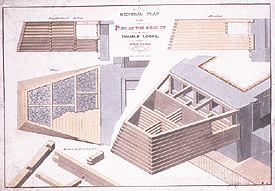

The function of a pier is to protect the lock, much like the pier between two lanes of traffic protects a toll booth on a modern highway. A fully-laden canal boat on the enlarged Erie Canal might weigh more than 200 tons. This enormous weight, striking part of the lock, even at three or four miles per hour, could cause serious damage. Shaped as triangles or trapezoids, their sloping sides also guide boats into the lock.
This is a generic plan for a pier. This pier is designed to protrude into the canal from the stonework that separates the two chambers of a double lock. The two drawings at the top show the pier from the side; the one to the left shows it from above. The main drawing, center right, shows the pier in perspective. Wood is portrayed in yellow and brown, stone in blue.
When constructed, this pier was framed in wood, its internal chambers filled with stone to absorb impact. The beams of this structure were joined by mortise and tenon, as shown at the bottom left. This pier would rest on solid ground at the level of the bottom of the canal channel. The stone to which it was attached would go below the level of the bottom of the canal.
Traffic increased enormously in the first few years of canal operation which resulted in major traffic jams at the locks. The locks and their wooden gates had to be protected from boat collisions especially since the momentum of a fully loaded canal boat moving at just 4 mph. was considerable and because steering and retarding the boat consisted solely of men thrusting poles into the bottom of the canal. All the competition and maneuvering to be next in line to go through the locks increased the risk of collision with the gates and fights among the men.
The following are excerpts from the Diary of Jonathan Pearson:
Wednesday, July 24, 1833
"The drivers were halloing and swearing, the boat was bumping and thumping against others,
and such a scene of confusion and furor of voices, I never heard."
August 17, 1833
"One mile soon brought us to an ascending lock which, owing to the crowd, it did not become
our right to use for more than two hours, a part of which was uselessly spent by the gangs of a
certain boat and raft in a wordy quarrel about their rights to enter the lock first. The only right
which either cared to use was might, which was so nearly balanced that for an hour neither could
get the advantage. While the unwieldy raft was approaching to enter, the boat sliped [sic]
nimbly
by and was half her length in the lock when she became completely wedged fast by the timber
raft, which entirely prevented her from going in or out. Each gang positively refused to move a
hair, vociferating in the most tremendous manner at each other and hurling volleys of such oaths
as even the Devil himself would be ashamed of had he been present (and why may I doubt this?)
The whole vocabulary of the language of Hell was exhausted, the most perfect pandamonium
[sic] was created and, had their courage been equal to their might pretensions, every soul of
them
would have been pummeled to death. Such men however fight best at a distance, like every
coward within his own dominion. Not withstanding all the altercation between the parties by the
interaction of the lock tending, the whole fuss ended with no other damage than the pushing of
one of the raftsman off the boat and the fall of another into the canal which considerable cooled
his ire, yet not before the Sheriff and Govt. had effectually searched after the master who,
knowing himself guilty of misdemeanor in the present fuss, secretly withdrew himself. Such
detestable occurrences are by no means seldom in every part of this canal."
http://www.eriecanal.org/UnionCollege/The_Pier.html